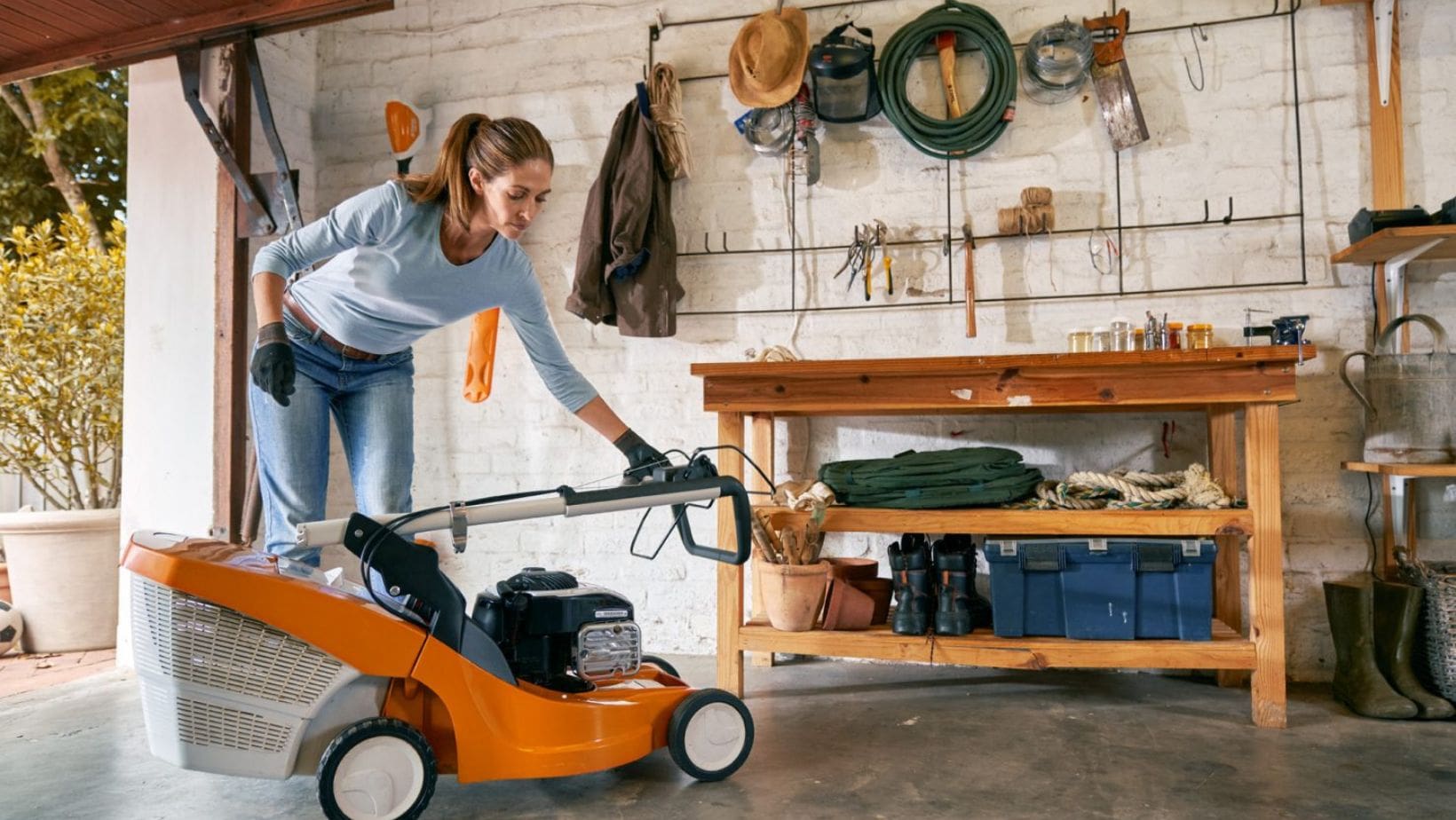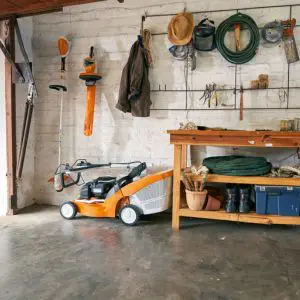
The Best Ways to Prepare and Store Your Garden Tools for Winter
With winter on the doorstep, it’s important to prepare and store your garden tools correctly, so they’re well protected from the challenging weather we’re likely to see over the next few months. Not only will this keep your garden tools in good working order and prolong their lifespan, it will ensure that they’re immediately ready for action once the sun comes back out next spring.
So, to find out the best ways how to clean and store gardening tools for the winter, please read on…
Preparing Garden Tools for Winter
Let’s begin by taking a look at the best ways you can prepare your garden tools for storage this winter. Take a small amount of time to follow this straightforward advice, and they will be entering storage in tip-top condition.
 Winter Tool Preparation 1: Drain Fluids
Winter Tool Preparation 1: Drain Fluids
If you own a petrol lawnmower, or other fuel-powered garden machine, it’s important to drain the fuel tank before putting it into storage for this length of time. Aside from the dangers of it leaking, this is because petrol is prone to degrading when sat idle in the tank. Not only will this reduce its effectiveness, it could also potentially damage your tool/ machine.
A potential alternative to draining the lawnmower fuel for winter is to use a fuel stabiliser. As this helps preserve the fuel’s integrity and protect the engine, it makes the need to empty the tank less imperative.
Although oil doesn’t degrade as quickly as petrol, it is good practice to empty it from its tank too. By doing this before you store your tools away for winter, you’ll help ensure next year’s oil is fresh and free of contaminants, optimising your tools’ performance and prolonging their lifespan.
Also, be sure to empty any water from your watering cans. Although stagnant water is unlikely to do the cans themselves any damage, it can be a breeding ground for bacteria, viruses and parasites.
 Winter Tool Preparation 2: Clean Tools
Winter Tool Preparation 2: Clean Tools
When cleaning garden tools for winter, firstly, remove any organic matter from secateurs, shears, lawnmowers, and the like. As well as discouraging garden pests, this will help maintain these tools’ functionality and increase their lifespan. When carrying out this task on your lawnmower, don’t just concentrate on the housing and blades, but be sure to pay attention to the grass catcher too.
When deciding how to clean garden tools for winter, match the way you clean according to the tool in question. For example, while it’s great to use soapy water on plastic and rubber parts, a slightly damp cloth is far more suitable for other areas.
Once done, be sure to thoroughly dry the tool/ machine before storing it away. Depending on the material it’s made from, this will help prevent rust or rot.
Winter Tool Preparation 3: Remove Rust from Tools
There are a variety of ways to remove rust. Perhaps the most obvious is by using an abrasive tool. This needn’t be a power tool, like a sander or grinder, because wire wool or sandpaper will usually do the trick.
You can also use a range of fluids to eliminate and protect against rust. White vinegar and baking soda paste are both effective, old-fashioned remedies, while many garden tool manufacturers produce their own specialist rust-removing solutions.
 Winter Tool Preparation 4: Sharpen Cutting Tools
Winter Tool Preparation 4: Sharpen Cutting Tools
Sharpening cutting tools clearly improves their performance. It also lengthens their lifespan because a sharpened tool needs less force than a blunt one to cut through the object in question. In turn, this puts less strain on the tool and so increases its longevity.
It makes perfect sense to carry out this job now. Then, once your secateurs, shears, lawnmower blades and chainsaw are cleaned and sharpened, the only thing left to do before they go into storage is oil them.
Winter Tool Preparation 5: Oil Tools
Oiling garden tools before winter can take a variety of forms. For example, it is good practice to use linseed oil on wooden handles. Unlike fence panels and sheds, they probably won’t have been treated prior to sale, so this will help protect them from rot.
WD-40 can be used to protect your metal garden tools from rust. That said, it is not designed for lubrication, so if you want to protect a tool or machine’s moving parts, use a synthetic oil, which is the best type of oil to limit friction.
 Winter Tool Preparation 6: Disconnect Batteries
Winter Tool Preparation 6: Disconnect Batteries
As cordless garden tools and machinery are the fastest growing area of the market, chances are you now own one or more of them.
To prepare these tools for winter, firstly disconnect the batteries. Failure to do so can cause corrosion and reduce both their effectiveness and lifespan.
Lithium-ion batteries should be charged to between 40 and 50 percent before being put into storage. Storing them fully charged can reduce their capacity, while leaving them dead risks the batteries dropping to a zero voltage state.
Winter Tool Preparation 7: Carry Out Inspections
A good visual inspection involves checking that all the necessary parts of the tool are present, secured and undamaged. Pay particular attention to screws and leads. If any are missing or not in A1 condition, now is a sensible time to replace them, so your garden tool is in prime condition to use next spring.
If you haven’t operated a particular tool in a while, give it a quick test run before putting it into winter storage. Again, this keeps you one step ahead of the game, so you’re not in for any unpleasant surprises when you eventually come to use it.
And don’t forget, a broken tool will waste valuable garden storage space, so be sure to dispose of it at your local recycling centre.
Storing Garden Tools for Winter
Once you’ve taken the time to clean, oil, and otherwise prepare your garden tools for winter, you don’t want to let all your hard work go to waste by storing them incorrectly. By doing the following, you’ll keep your valuable tools and equipment protected from the winter weather and ready for immediate action once you’re back out in the garden.
 Winter Tool Storage Tip 1: Customised Tool Storage (Including Storing Lawn Mower)
Winter Tool Storage Tip 1: Customised Tool Storage (Including Storing Lawn Mower)
Over winter, most people store their garden tools in the garage or shed. This is good practice because it protects them from both the weather and thieves, but it does mean these places can get rather cramped. And if delicate items, like outdoor cushions, come into contact with sharp metal blades, they’re going to get damaged.
One way around this is to store some garden products in isolation. In the above example, you could do this by purchasing either a cushion box or tool store. The latter are usually tall but with a small footprint, so they can accommodate long-handled tools while only taking up minimal patio space.
Mower Winter Storage
There are outdoor storage units designed for various garden machines too. For specialist lawn mower winter storage, it’s worth checking out a mower store. These customised wooden units are undoubtedly the best way to store a lawn mower for winter.
The other major benefit of buying a patio storage unit is that it’ll ensure your frequently used tools are exceptionally well organised and always to hand.
 Winter Tool Storage Tip 2: Use Hooks, Shelves and Toolboxes
Winter Tool Storage Tip 2: Use Hooks, Shelves and Toolboxes
If you don’t want to invest in specialist tool storage and are intent on keeping everything in the garage or shed, it’s essential to get it organised. The starting point here is to instal some hooks and shelves, as well as invest in a tool box.
Doing this both protects the tools and prevents their blades from damaging other items. And by keeping your tools off the shed or garage floor, you’re also shielding them from ground moisture, again prolonging their shelf life.
A specific advantage of hooks, of course, is that they can be used to hang long-handled tools, both vertically and off the floor. This makes them extremely effective at maximising your available storage space.
Winter Tool Storage Tip 3: Further Organisational Ideas
If you want to store slightly larger tools in the shed or garage, and you no longer have the tools’ original packaging, why not invest in some plastic containers from your local DIY shop? As they won’t have distinguishing marks, it’s a good idea to label them. This will obviously save you a lot of time when you come to unpack, next year.
We also recommend entering the word ‘storage’ into the search bar on the homepage of our website. Garden Machinery Direct sells a variety of high-quality storage products, many of which are customised to protect specific branded products. And if you’re looking for a bag or box in which to store a chainsaw, you’ll find one here.
 Winter Tool Storage Tip 4: Cover Blades
Winter Tool Storage Tip 4: Cover Blades
When you store your garden tools for winter, pay particular attention to their blades. If the tool wasn’t supplied with a protective sheath, wrap the blades in a towel or cloth.
Not only will this protect the tool’s cutting mechanism, it will prevent it from damaging other items or causing you possible injury when you’re moving around your chosen winter storage facility.
Winter Tool Storage Tip 5: Storing Batteries Over Winter
Regardless of whether you have room in the shed or garage, it’s always a good idea to store any batteries inside the house, once you’ve disconnected them from their tools. (This definitely applies when storing a lawn mower battery for winter.)
The reason for this is that batteries are best stored at room temperature, in a completely dry place. Also, ensure they’re kept out of direct sunlight and other sources of heat, either within their original packaging or another closed container.
 Winter Tool Storage Tip 6: Use Protective Covers
Winter Tool Storage Tip 6: Use Protective Covers
Certain garden tools/ machines might be too big to store within your shed or garage, if these places are already close to their storage capacity. In this case, or if they’re particularly valuable, it’s wise to invest in a protective cover.
Riding Mower Winter Storage
The most common type of garden machine that benefits from its own protective cover is a ride-on or tractor mower. We stock an excellent range of covers designed for this purpose. Made by some of the world’s leading manufacturers of riding mowers, they are customised to fit specific models or sizes of mower. You can view them all here.
And the Best Time to Store Your Garden Tools for Winter?
The answer to this question is now! The sooner you prepare and store your garden tools for winter, the better protection they’ll receive over the coming months. Trust us, you won’t regret doing it when you come to use your tools next spring.




